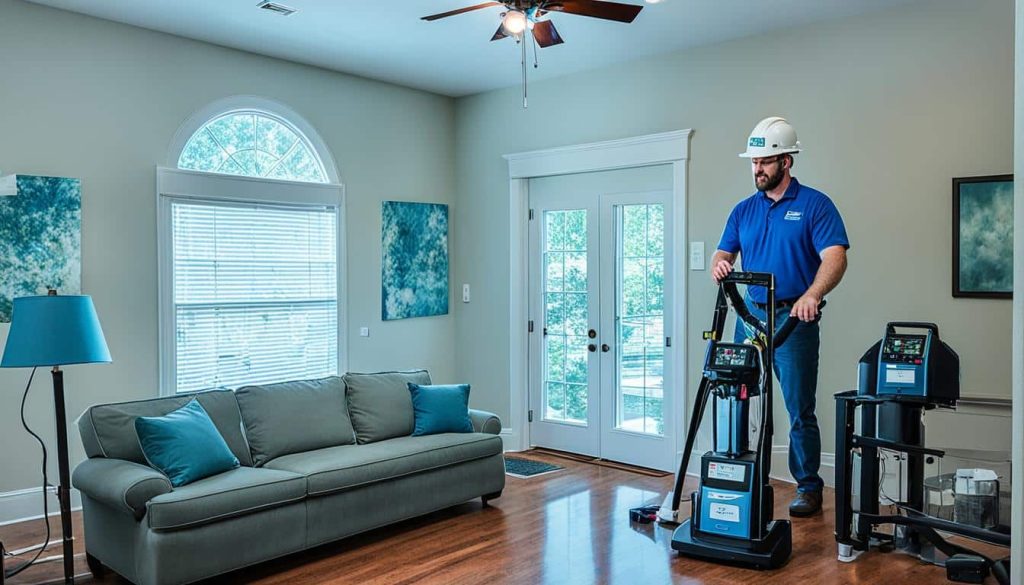Table of Contents
Many of us worry about the air we breathe indoors. We often ask, “How Accurate Are Home Air Quality Tests?” and wonder about the accuracy of home air quality tests.
Seeking answers to these questions is common. We all want to know the truth about indoor air.
It’s true that many homes have pollutants. So, we looked into home air quality tests. We explored both DIY and professional options.
This article will explain what these tests can find and their limits. We’ll talk about when it’s important to get one. This is for keeping your indoor air clean at home or work.
Ready to learn more? Let’s get started!


Key Takeaways
- Home air quality tests check for pollutants like mold, radon, and carbon monoxide. Each test works in a different way.
- These tests have limits and might not find every problem. Also, professional testing can cost a lot but gives clear results.
- Poor air from dust or chemicals causes health issues like coughing or tiredness. Visible signs include mold on walls and musty smells.
- We should test our home’s air at least once a year or more if we see signs of bad air or live in places with lots of pollution.
- Air purifiers help clean our indoor air. They work best with HEPA filters and need regular cleaning to keep working right.
Understanding Home Air Quality Tests
Home air quality tests can help us check if our indoor air is safe. There are different types, like digital monitors and mold tests, each serving a unique purpose.Types of tests (digital air monitors, mold tests, radon tests, carbon monoxide detectors)
Home air quality tests come in different forms. Each type helps us understand what’s happening in our indoor spaces.- Digital Air Monitors These monitors keep track of indoor air quality. They measure various pollutants like dust and allergens. We can connect them to our smartphones for real-time data. This technology makes it easier to notice changes in air quality.
- Mold Tests Mold tests check for the presence of mold spores in the air or on surfaces. We can find DIY air quality test kits at local stores for this purpose. Professional mold testing is also available if we suspect a serious problem. Mold can cause health issues, so quick detection is vital.
- Radon Tests Radon is a gas that can enter homes through cracks in the foundation. Long-term exposure can lead to serious health risks. Radon tests measure levels of this gas in our homes. Using a radon detector ensures we keep our living spaces safe.
- Carbon Monoxide Detectors Carbon monoxide is an odorless and colorless gas that comes from burning fuels. It can be deadly if not detected early. Placing carbon monoxide detectors near bedrooms helps protect us while we sleep. Regular testing ensures they work properly.
How they work
Home air quality tests work in several ways. Digital air monitors measure particles in the air. They detect things like dust, pollen, and smoke. Mold tests look for specific mold spores in the home. Radon tests check for this harmful gas that can come from the ground. Carbon monoxide detectors alert us to dangerous levels of CO, which is odorless and invisible. Each type of test has its own method. For example, digital monitors use sensors to gather data on indoor air pollutants. We often need to keep these devices running for accurate readings over time. Some tests require samples sent to labs for analysis. Knowing how each test works helps us understand their strengths and limits better as we focus on improving our indoor air quality.Limitations
Home air quality tests have limits. They don’t catch every air problem. Some digital air monitors might miss certain particles or contaminants. Mold tests can find mold, but they don’t show how much is in the air. Carbon monoxide detectors warn us of danger, but only at high levels, not low ones. Cost is another factor. Professional air quality testing gives clear results but can be pricey. We should consider how often we need to test and if an indoor air quality monitor is enough for us. Many things affect our indoor air quality, like how well our home is ventilated and outside pollution. It’s important to know these limits as we try to make our home healthier.
Signs of Poor Air Quality in a Home
Poor air quality in a home can show up in many ways. We might feel headaches, fatigue, or breathing issues. Visible signs include mold growth, discolored walls, or a musty smell. These clues can help us understand if our indoor environment needs attention.Health symptoms
Poor air quality can cause many health problems. Knowing the symptoms helps us act quickly.- Coughing and Sneezing These are common signs of poor air. Dust, mold, or chemicals in the air can irritate our lungs and throat.
- Allergic Reactions Many people suffer from allergies due to indoor air pollutants. This includes runny noses, itchy eyes, and skin rashes.
- Headaches Bad air quality may lead to frequent headaches. High levels of carbon monoxide or other pollutants can be the cause.
- Fatigue Feeling tired often might link to poor air in our home. Poor air quality affects our breathing and energy levels.
- Shortness of Breath Some may find it hard to breathe in a polluted environment. Those with asthma or other lung issues should pay close attention.
- Nausea Sometimes, people feel sick because of bad indoor air. Pollutants can upset our stomachs and make us feel unwell.
- Irritation of Eyes, Nose, or Throat Clean air should not irritate us at all. If we feel burning sensations in these areas, it signals trouble with the indoor air quality.
- Increased Illnesses We may notice more colds or infections if the air isn’t clean. Poor ventilation lets germs thrive, making us more vulnerable to illness.
Visible signs (mold, discolored walls, musty odor)
Visible signs can alert us to poor air quality in our homes. We should pay attention to what we see and smell.- Mold: Mold often grows in damp areas. It can appear as black or green spots on walls or ceilings. Breathing in mold can cause health problems, specially for those with allergies or asthma.
- Discolored Walls: Walls that change color may show that moisture is present. This discoloration can indicate water damage or leaks, which harm our indoor air quality.
- Musty Odor: A musty smell often points to mold or mildew growth. If we notice this odor, it’s a red flag that we need to check the air quality in our home.
- Dust Accumulation: Excessive dust build-up might mean air pollutants are in our space. High levels of dust can signify poor ventilation and dirty air filters.
- Condensation on Windows: If we see foggy windows, it might indicate high humidity levels indoors. This excess moisture can lead to mold growth if not addressed quickly.
Factors to Consider Before Testing
Testing your home’s air quality is important, but there are a few things to think about first. We need to consider how often we should test and the costs involved with hiring professionals for accurate results.Frequency of testing
We should test our home air quality regularly. Experts suggest doing this at least once a year. If we notice any signs of poor air quality, like mold or musty odors, we need to test sooner. Our homes can trap dust and pollutants that affect our health. Using a digital air monitor helps track changes in indoor air quality over time. Some factors may change how often we should test. If we live in an area with high pollution or if someone has asthma, more frequent tests are wise. Carbon monoxide testing is also important for safety. We all want clean and safe air in our spaces, so regular checks are key for good health.Cost of professional testing
Professional testing for air quality can be expensive. Prices vary from $200 to $800, depending on the tests needed. Mold and radon tests usually cost more. Indoor air quality assessments might include several tests. These check for airborne contaminants and particles. Companies offer services that give detailed reports. Home air quality monitors can be cheaper. But, professional testing offers more accurate results. Getting expert help helps us understand our home environment better. It keeps our families safe from harmful pollutants. For more information, contact Array of Solutions.Effectiveness of air purifiers
Air purifiers can improve indoor air quality. They remove dust, pollen, and smoke. Many use filters, UV light, or ionizers for cleaning. Using an air purifier can reduce allergens in our homes. The cost of air purifiers varies. Look for one with a HEPA filter for effective particle trapping. Regular maintenance is important for their performance. A clean filter ensures better results in improving our home’s air quality.Conclusion
We’ve looked at home air quality tests together. We’ve learned about different types and their uses. Each test helps us understand our indoor air better. But, they have limits we should know. Signs of poor air quality are important to spot. Health problems and visible issues indicate a problem. Testing can help, but we must consider costs too. These steps can lead to better living conditions for everyone. Have you checked your air quality recently? Improving air quality is key for health and comfort at home or work. For more tips, check local resources or hire experts like Array of Solutions. Consulting professionals ensures a healthier tomorrow!

